Call center quality assurance: A guide from a CS leader

Team Lead, Support QA and Development
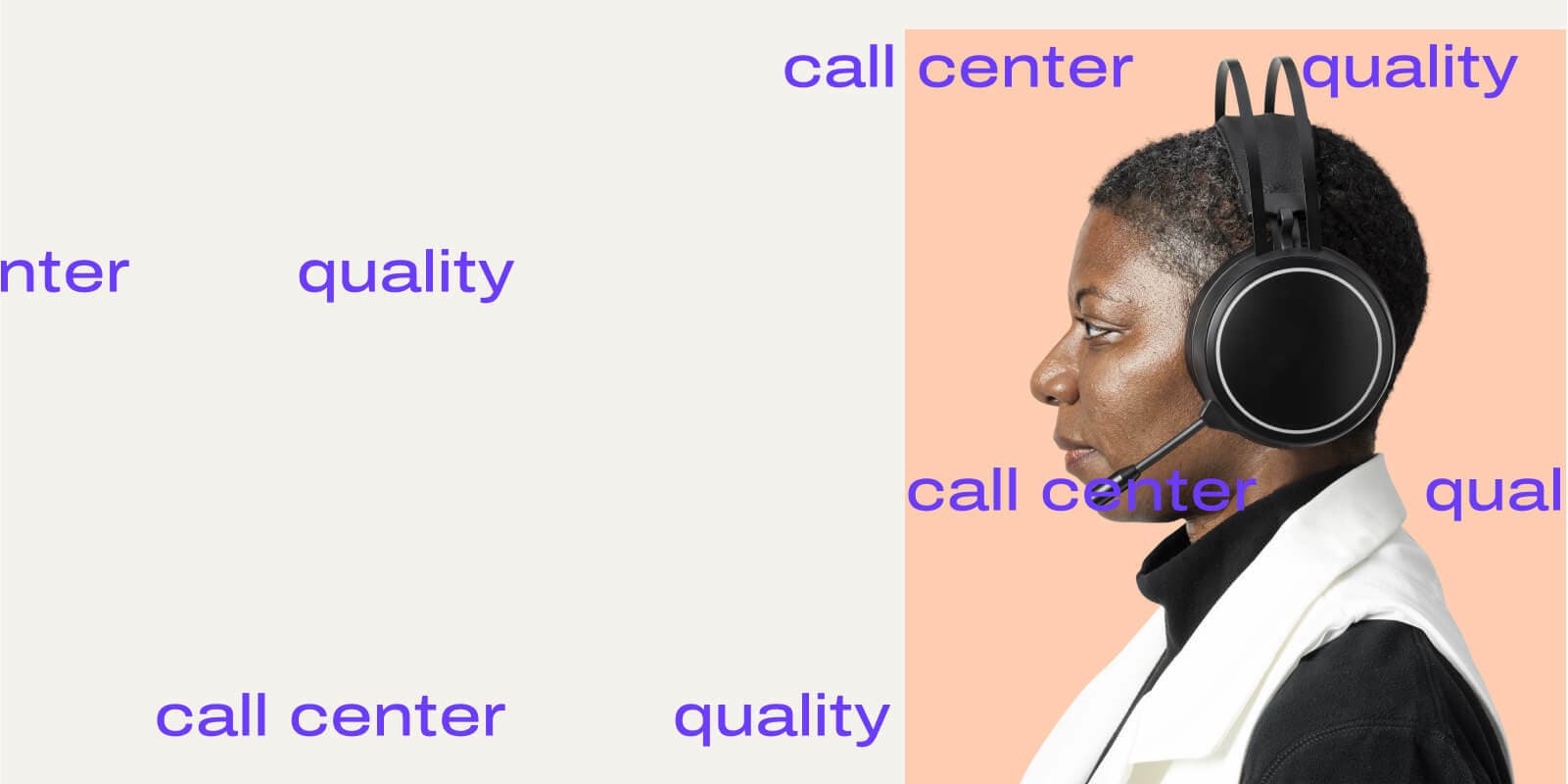
Tags
Share
Let's face it. Customers are well aware that they deserve exceptional service—and if your business offers anything less...well, prepare to wave goodbye to their money. In fact, 73% of consumers say CX is the number one thing they consider when they’re deciding whether to buy from a company.
Thing is, receiving poor service from a call center is an all-too-common complaint. (And tech-savvy customers aren't shy about sharing their negative comments on social media.)
So how can your call center improve customer satisfaction while still committing to continuous monitoring, evaluation, and improvement? In my experience, a good quality assurance process is crucial.
Managing five call centers and more agents than I can count, I'm deep in the trenches of contact center management every day. And in this post, I'll walk you through what's involved in quality assurance, and specific ways in which you can use a contact center solution to put it into practice.
First, let's have a quick refresher on what quality assurance is and what it looks like.
What is call center quality assurance?
Call center quality assurance is the process by which a team (or person) ensures their call center is providing positive customer experiences. This is done by identifying and preventing potential problems effectively. Quality assurance is also a great way to reduce costs, because it helps you spot inefficiencies like agent downtime and unmanageable call volume. (Really helps with staffing!)
👉 Dialpad tip:
Quality assurance (or QA) can be done in-house, led by managers or supervisors, or you might hire external QA specialists. Their job is to monitor the call center's operations, gather and evaluate data, and use it to help agents boost their performance. But often that's not possible, and QA is done by team leaders or supervisors who are incredibly busy—if that's the case, arm them with tools designed to get them high QA coverage.
QA managers typically use methods like call monitoring, call scoring, and side-by-side coaching to assess agent performance, call quality, and other key performance indicators (KPIs) like qualitative customer feedback for further insights.
While some quantitative analysis is carried out by software, you still need that human element to evaluate customer interactions and nuances. (Good to know the machines haven't replaced us just yet!)
Quality assurance is essential in running a successful call center. Next, let's look at different QA methods and how to solidify your call center as a key asset for your business.
What’s the difference between quality assurance, quality control, and quality management?
Call center quality management involves a few processes that often overlap with each other. Quality assurance (QA) is a proactive approach that focuses on monitoring and evaluating agent-customer interactions to ensure compliance with standards, followed by feedback and coaching.
Quality control (QC), on the other hand, is more reactive and involves identifying and addressing issues in real-time to maintain service consistency.
Finally, quality management tends to encompass both QA and QC, along with performance analysis, process improvement, customer feedback analysis, and continuous agent training to ensure long-term service excellence and operational efficiency.
Creating a call center quality assurance framework
I'll be honest—successful quality assurance requires a lot of hard work. But a structured approach makes it a lot more manageable.
Consider incorporating these aspects into your framework:
Operations. Start with the basics by establishing a system for regular call evaluations to identify underperforming agents. For example, you could incorporate Ai-powered scorecards to automate scoring and ensure consistency. This is where you’d set clear performance benchmarks and provide agents with real-time feedback to encourage continuous improvement.
Tactics. Identify recurring workflow bottlenecks, common customer pain points, and training gaps that may be affecting performance. For example, if certain agents struggle with complex product inquiries, provide some targeted coaching sessions or implement knowledge base enhancements.
Strategy. Align QA with long-term business objectives like improving Net Promoter Score (NPS), reducing churn, or increasing customer loyalty. To inform your strategy, you might use Ai or predictive analytics to anticipate customer needs and adjust staffing or workflows proactively.
✨ Want to improve your contact center's performance?
Grab the Contact Center Playbook, which breaks down everything you need to know, from setup to improving customer satisfaction—with examples from real contact center teams across different industries.
Examples of call center quality assurance metrics to track with your framework
Some key call center quality assurance metrics include First Call Resolution (FCR), which tracks issues resolved on the first contact; Average Handling Time (AHT), which measures the duration of interactions; Customer Satisfaction (CSAT) and Net Promoter Score (NPS), which assess customer experience and loyalty. Learn more about call center KPIs.
How technology has evolved to help with quality assurance
Call center quality assurance has evolved beyond traditional monitoring, thanks to Ai-driven solutions that enhance efficiency, accuracy, and agent experience.
Real-time conversational analytics, for example, enable managers to track interactions as they happen, using Ai-powered transcriptions and sentiment analysis to detect customer frustration or compliance risks instantly.
This is an area where Dialpad Ai shines with its real-time call transcription and sentiment analysis. That means that even if I'm managing 20 or 30 agents in my call center, I can easily spot if and when customers are getting angry or upset during any of these calls in real time (and afterward in post-call summaries too) and jump in to help agents de-escalate when needed.
Predictive analytics helps forecast potential issues, optimize staffing, and identify training needs before they impact performance. This is especially helpful when you’re doing workforce scheduling—Dialpad Support has WFM features that can automate this process, and the Ai-powered QA scorecards feature automatically analyzes calls and suggests grades for agents, which reduces the manual effort needed while ensuring consistency:
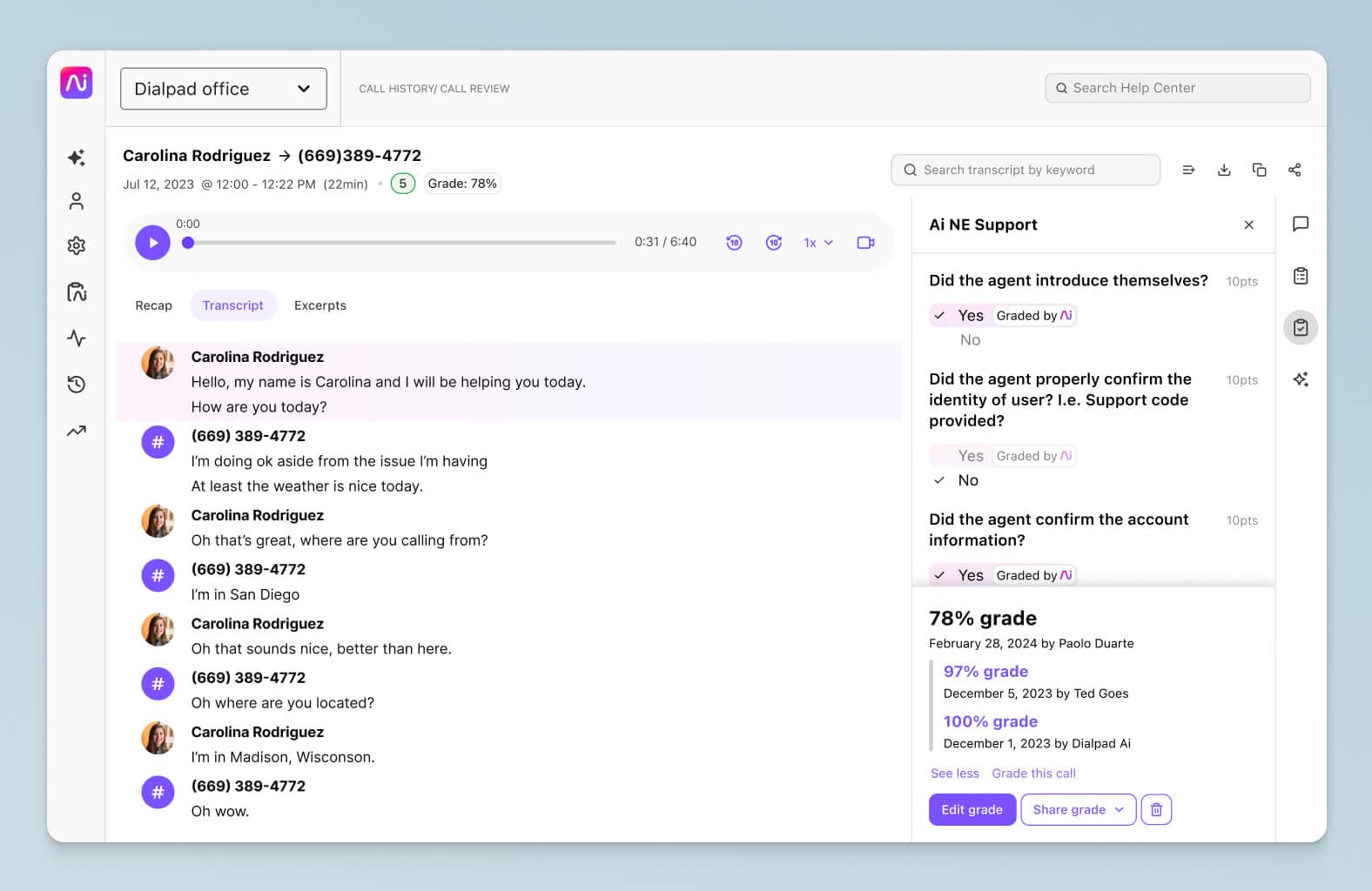
8 call center quality assurance best practices
Now that we've looked at some of the advantages of a good quality assurance system—now let's look at some of the best ways to make it happen.
1. Have clear criteria and scorecards
The criteria you use to measure call center quality is just as important as the evaluations and feedback. As well as examining KPIs, you'll want to assess how agents deal with irate callers, and comply with regulations such as the Do Not Call (DNC) registry.
Make sure you provide documentation that explains the criteria for each interaction, so that agents know exactly what is expected of them. Many call centers find it useful to create a Quality Standards Definition Document (QSDD), outlining the information that needs to be evaluated.
But it's important to remember that different types of calls should be measured against different criteria—for instance, a sales call (learn more about sales call reporting) is not the same as a technical support call. Different channels will also involve different metrics for measuring the effectiveness of interactions.
You need a scorecard system that reflects this variation and accurately represents each agent's performance against measurable benchmarks. Agents and managers should work together to develop benchmarking, so that everyone understands what the scorecard includes and why it matters.
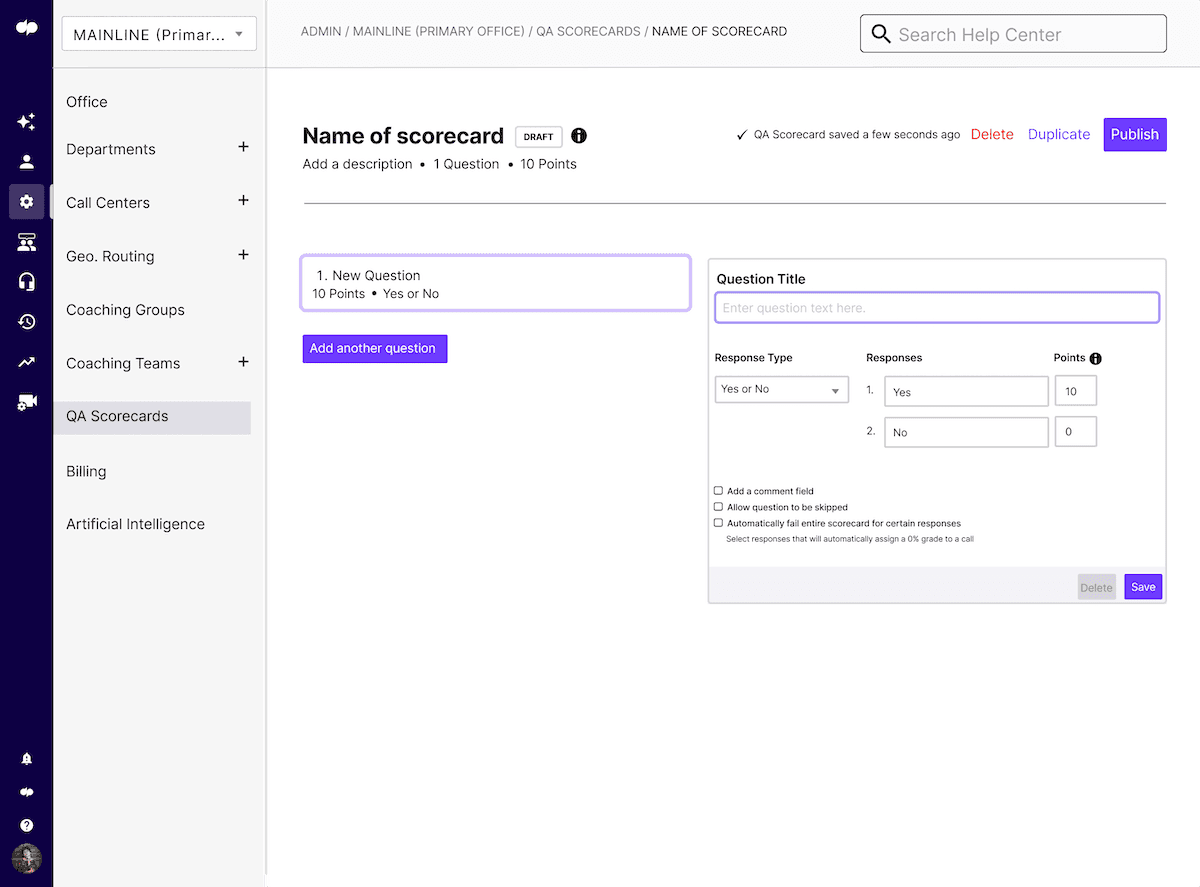
2. Use a large enough sample size to ensure objective QA
One of the biggest challenges with traditional QA reviews is that supervisors often have to "cherrypick," or choose calls at random to review. This problem of time and scalability comes up in any large contact center. With the sheer amount of calls placed into a contact center across all your agents, it's very difficult to review calls for quality and consistently provide objective feedback in a way that will help your teams succeed.
That's where Dialpad Ai comes in.
Dialpad Ai Scorecards are a new tool that helps contact center supervisors and QA teams scale call reviews and provide objective feedback to agents quickly.
Supervisors and admins can easily create a QA Scorecard, and as the contact center agent handles calls, Dialpad Ai listens to the interaction and automatically suggests when the scorecard behavior is met:

For example, the scorecard behavior might be “Agent asked the customer for their email ID.” If the agent asks for the customer's email, whoever grades that call will immediately see that the activity was completed, without having to listen to the entire call recording or read the transcript.
This allows contact center teams to scale QA reviews across a much wider range of calls than would otherwise be possible—which results in more effective agents, happier customers, and much improved customer satisfaction metrics.
3. Have one person who's accountable for managing the QA process
QA managers and evaluators have their work cut out for them, keeping an eye on the performance of so many agents as well as directing workflow operations. If you can, it's best to hire someone with experience in call center QA best practices and getting the best out of their team.
You can be involved in performance management, of course, by monitoring calls or arranging follow-up coaching sessions, or side-by-side coaching to assess an agent's performance in real time. But you can't do it all. (I know I can't, because I manage five call centers!)
Make sure you have the right tools that allow you (or whoever's accountable) to do things like see how agents handle a live call and read call transcriptions on your own time.
One feature in Dialpad that's really helpful is the ability to create a “call library”—we call it a playlist—of good or bad calls for training purposes. Have some recorded calls that would be good for your agents to learn from? Add them to the playlist!
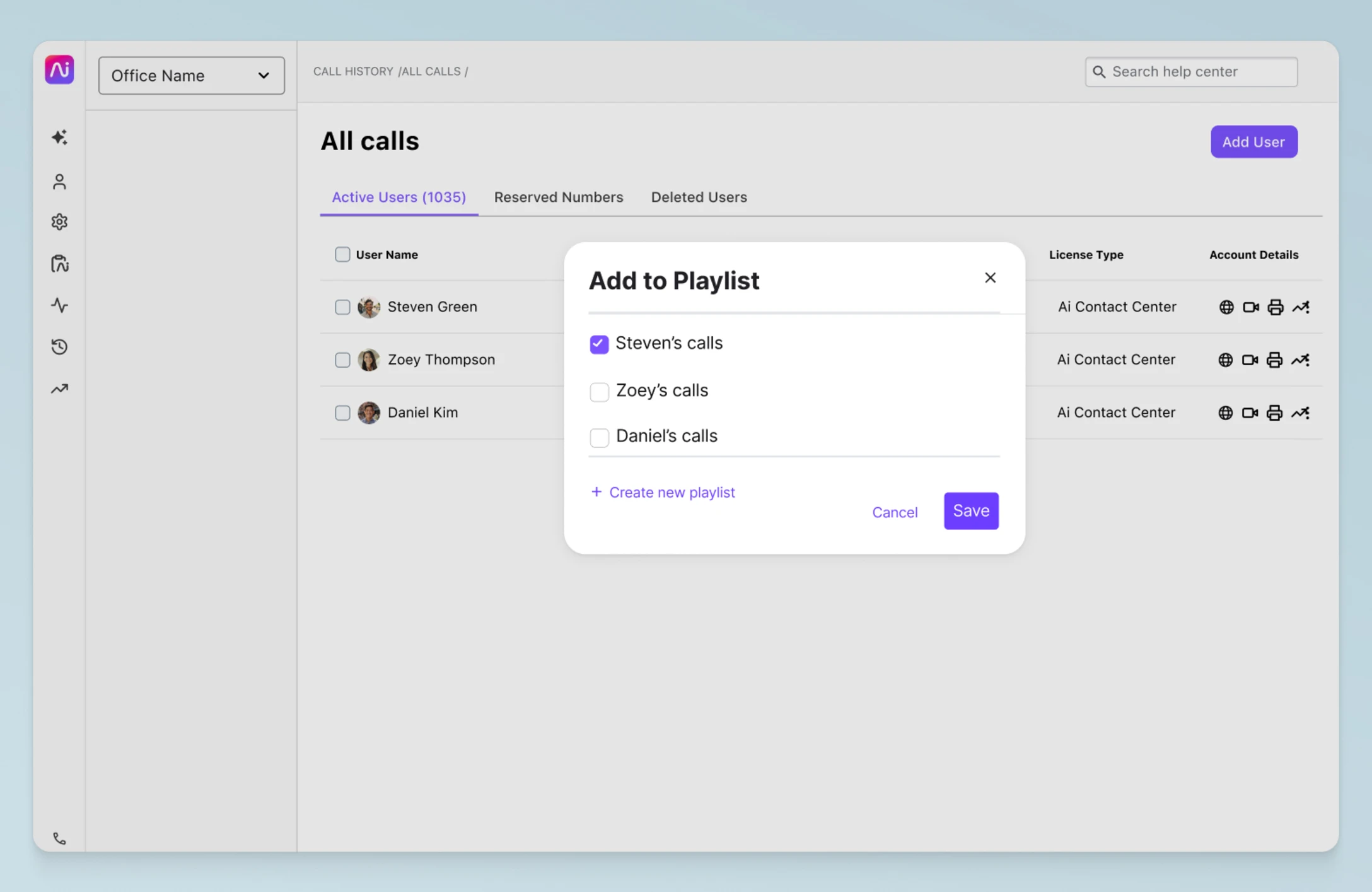
You should always recognize and reward agents when they've done a good job. Another way to foster agent engagement and loyalty is to use gamification, creating challenges and activities for a fun way to achieve key goals.
4. Share knowledge as a team
As we mentioned earlier, QA provides lots of opportunities for the whole team to get involved— from planning to evaluations and improvements. Agent collaboration is a key part of making QA run smoothly… if you involve them in your process!
Collaborative teams can learn from each other, not only because everyone brings a different skill set to the table, but also because everyone takes different customer calls and fields wildly different questions every day. As a manager, you need to find a way to gather all this knowledge and make it accessible to everyone so that you can all learn from each other as quickly as you can.
My team does this with Real-time Assist (RTA) cards. After we analyze call recordings and data, we may find that there are patterns. Maybe there's a tricky question that customers ask about certain products (or if you're in sales, certain objections that keep coming up). We can create RTA cards to help agents answer these questions.
For example, I can create an RTA card with notes on how to talk about our number porting process, and set it to pop up automatically whenever a customer says “porting” or “port” on a call). If the agent doesn't need the tips, they can just close the card and carry on with their conversation. But it's there to help if they need it.
Dialpad's Ai Live Coach feature also automatically searches all our knowledge bases (including unstructured data sources like PDFs and even past customer calls) to flag helpful information for agents as they're talking to customers:
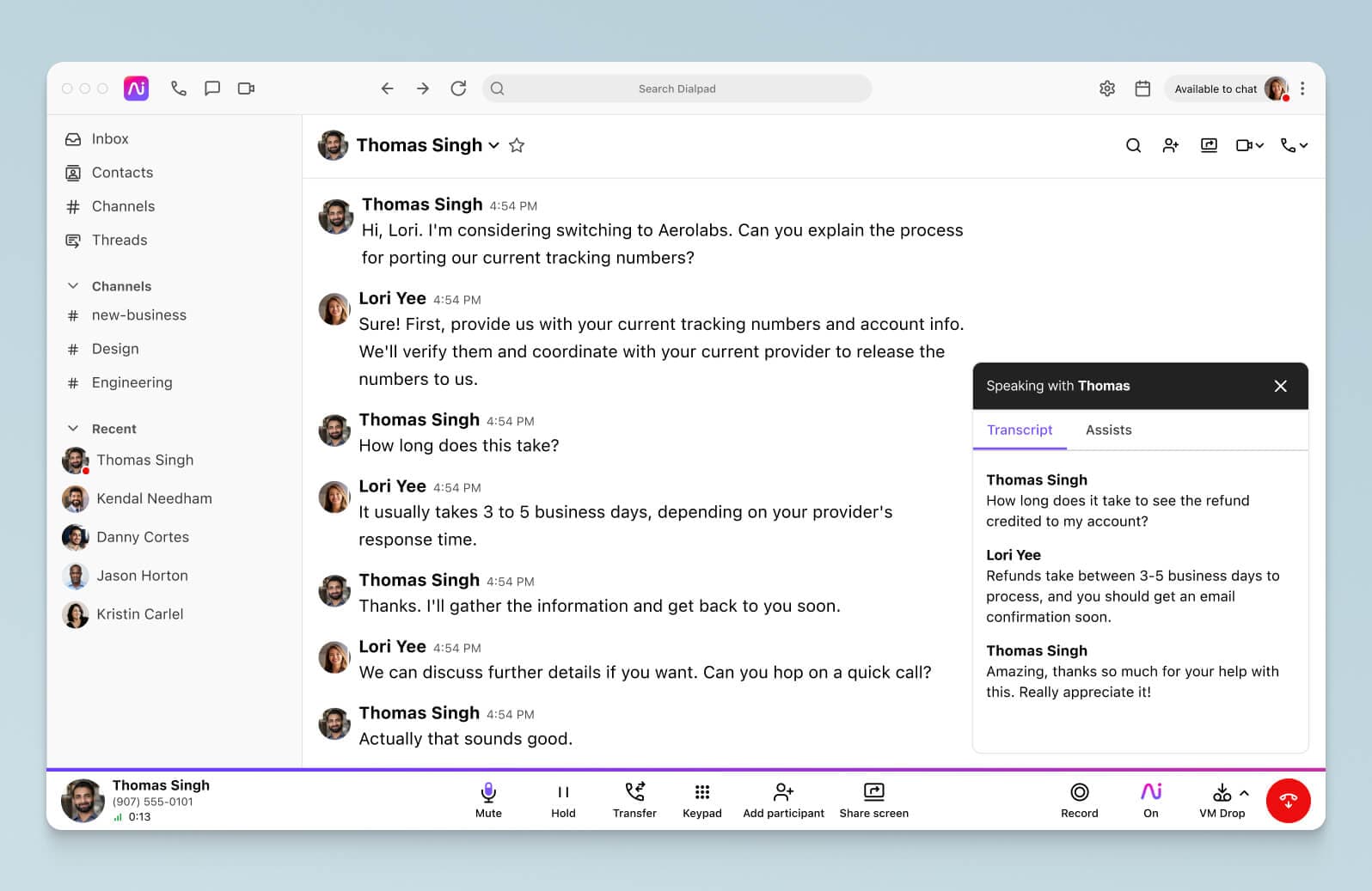
If you work in a large organization or one with a dispersed workforce, it's even more important for your agents to feel like they're supported. A good contact center management tool has made that possible for us.
👉 Dialpad tip:
Remember, an effective call center quality assurance program takes agent feedback into account, so make sure you listen to your team, take action on their suggestions if they're good, and tell them when their contributions have led to a positive change.
5. Evaluate your agents consistently
This might sound obvious, but you'd be surprised at how many call center managers don't do this.
Make time to evaluate your team. They deserve to know how they're performing, and your boss will want to know as well.
Calibration sessions (basically, getting everyone onto the same page) will help you see whether the evaluators are scoring interactions by the same standards. Ideally, call centers should calibrate at least one call every week—and even more regularly when you introduce a new evaluation form.
It's also vital to evaluate as many interactions as possible to get a good overview of call center performance. Even the same agent can perform at different levels on different days, so continuous measurement is the only way to make a fair and accurate assessment.
There are a number of ways you can monitor interactions, from simply listening in, to fully automated solutions.
Some call centers use random sample monitoring, where supervisors examine an arbitrary selection of calls or interactions. This method will sometimes reveal areas for improvement or examples of best practice, but it's hit-and-miss—it's not going to show you the overall state of your contact center.
👉 Dialpad tip:
Targeted monitoring is a more insightful technique, as it focuses on specific conversations. You might choose to monitor interactions with high-value customers, or agents following up with customers who complained or gave negative feedback.
The targeted approach provides quality assurance analysts with more relevant information, and also helps you spot agents who are particularly successful or those who might need some extra coaching.
Another option is to use analytics-driven quality monitoring in your QA program. This type of quality management uses automation more heavily, and it's what we do here. (Yay speech and text analytics!)
Because automated monitoring can evaluate and categorize all of your interactions for you, you get a more accurate overview of performance—it gives me more time to spend on actual targeted coaching and helps me see key trends more quickly too.
Make sure your call center solution offers a range of ways to support quality monitoring. Dialpad Support, for example, lets me see at a glance what our hold queue looks like, how many agents are available, how many live calls are in progress, and more:
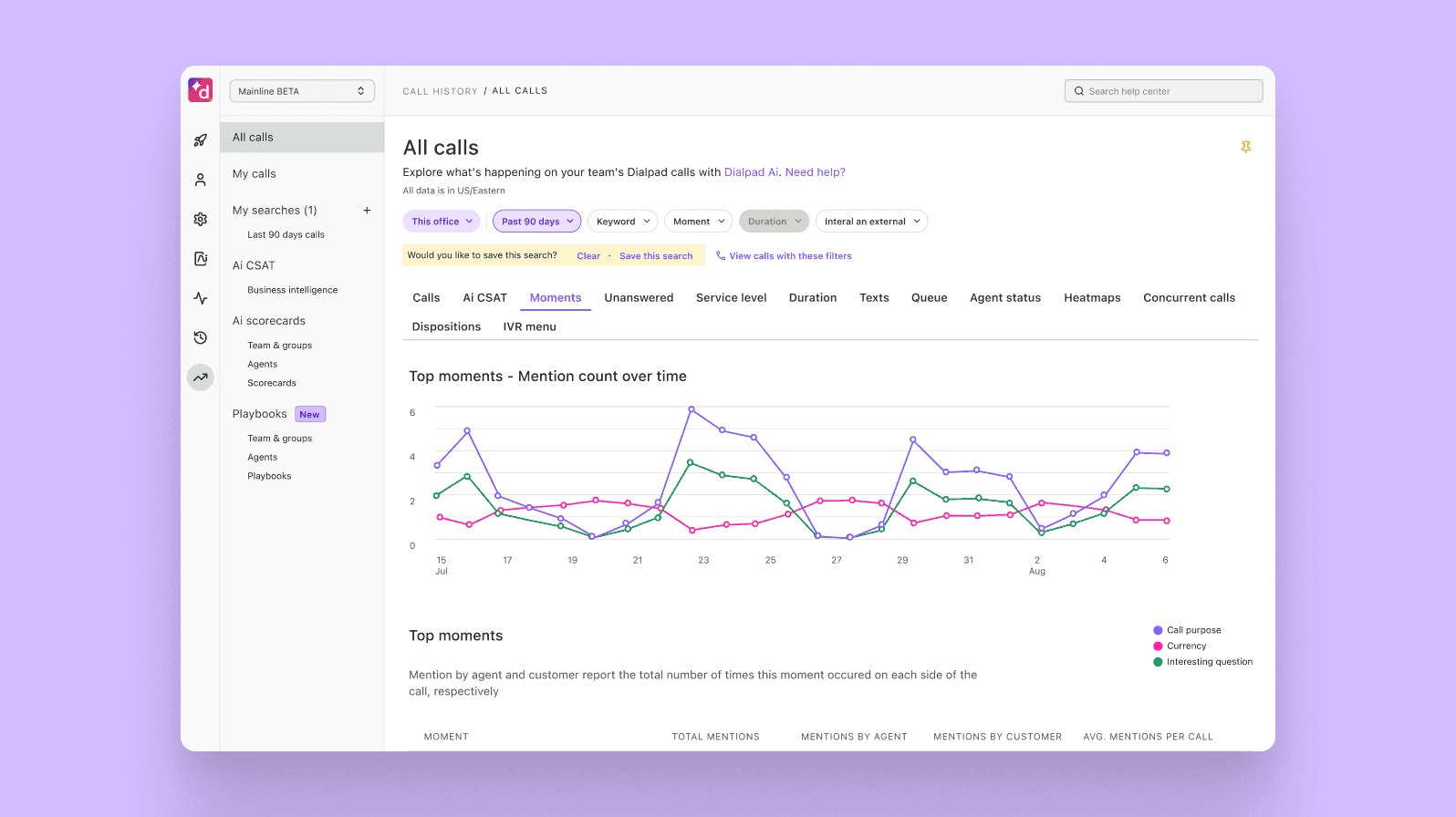
👉 Dialpad tip:
In a contact center with omnichannel communications (across social media channels, emails, and calls, and so on), you need full visibility into the quality of all interactions—not just phone calls. Here, you might find it helpful to create different evaluation forms for each channel, as each one might have specific standards and requirements.
To keep your agents engaged, let them evaluate their own interactions and compare the scores with those of the evaluator. They should also have the means to dispute an evaluation or score, so that you can have a more collaborative discussion on improvement.
Again, having accessible data is helpful here. If your agents can all see a dashboard that displays QA scores and evaluations, it'll encourage accountability and empower them to self-correct (provided you made good hiring choices).
6. Implement call calibration to improve consistency
Call calibration is a pretty crucial step that helps ensure your QA evaluations are fair, consistent, and aligned with the company’s overall goals. Without a structured calibration process, different supervisors and QA analysts might score the same call differently, which leads to inconsistent feedback and confusion for your agents.
To implement an effective call calibration process, here are a few tips to keep in mind:
Schedule regular calibration sessions. Bring together QA analysts, supervisors, and even agents to review the same call recordings. Ideally, these sessions should be conducted biweekly or monthly to help everyone stay aligned.
Standardize evaluation criteria. Make sure everyone understands how to apply scoring criteria uniformly. A good way to do this is to document clear guidelines for handling common call scenarios, like dealing with irate customers or following compliance protocols.
Involve your agents. Engaging agents in this calibration process helps them understand why they’re receiving certain QA scores and how they can improve. Encourage them to ask questions and provide feedback on the evaluation process.
7. Provide regular feedback
I mentioned the importance of receiving and acting on employee feedback earlier, but what about the feedback you give to your agents?
One pitfall is mixed messages: this is a common one if you're not mindful of consciously providing feedback at all times, and it can lead to inconsistent performance—and if you praise or criticize one agent more than another for the same thing, you'll end up with a disgruntled team.
As well as good feedback, employees need to hear constructive criticism. Finding fault is easy, but it's harder to critique while helping them see the way to improve. If you have less experienced QA specialists and supervisors, you should provide training to help them communicate areas for improvement in a supportive and encouraging way.
Instead of reproaching agents when they make a mistake, collaborate with them to figure out a productive way forward. By using QA scores as part of agents' appraisals, you can show them tangible markers of performance (and it gives you a baseline for communicating quality assurance to the rest of the company).
8. Schedule proactively
There are two aspects of QA scheduling in a call center. The first is about developing a schedule for the overall QA program, to determine when tasks like evaluations and calibrations are due to be carried out.
We've already mentioned that these tasks should take place on a regular basis, so that you're monitoring as many interactions as possible and making sure they're judged by consistent standards. (It helps if evaluations are carried out shortly after an interaction, so that the details are still fresh.)
Dialpad Support has a great heatmaps feature that shows us both average call volumes and average speed to answer at different points in the day:
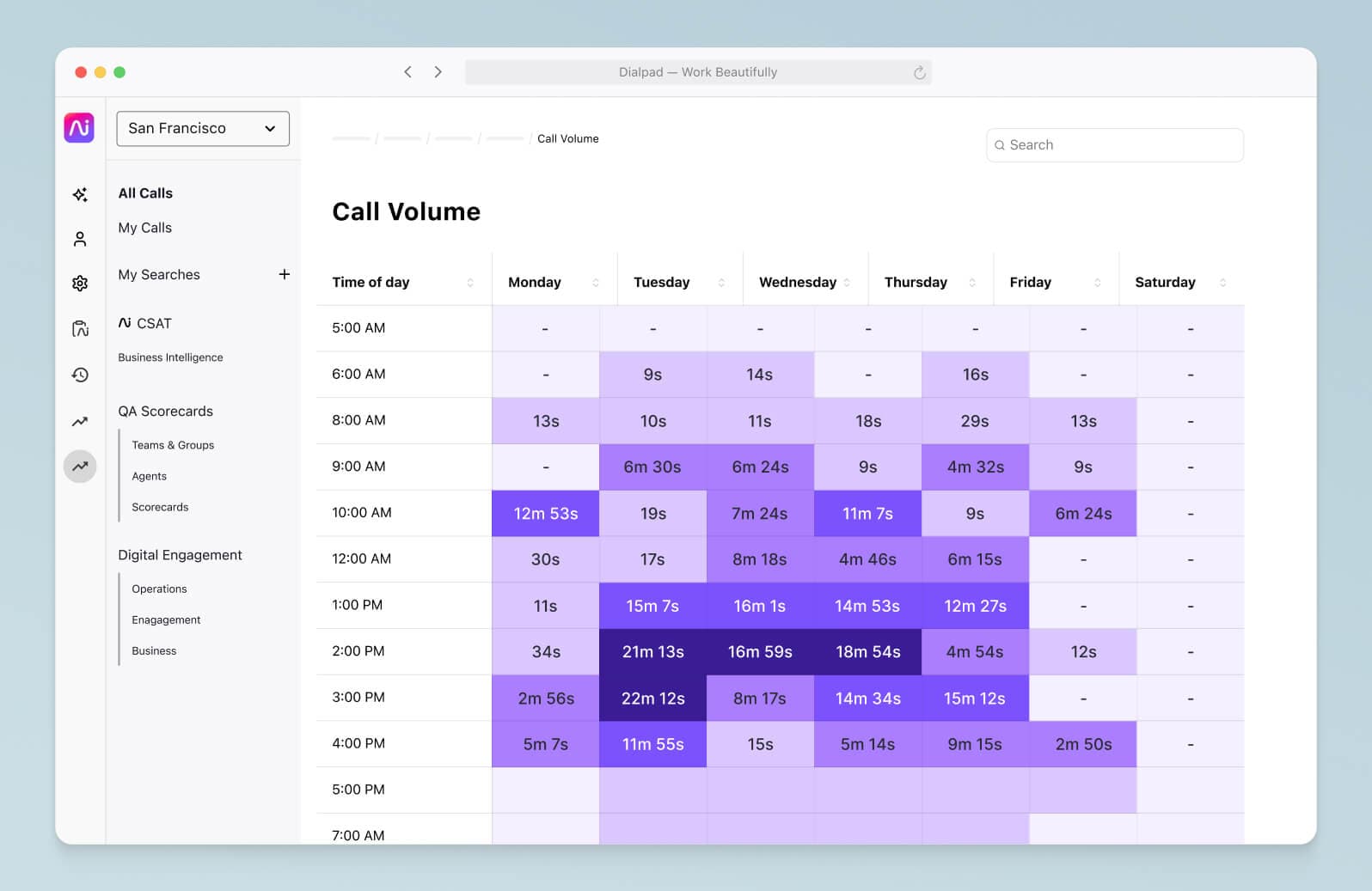
The other part of scheduling is about making sure that agents adhere to their assigned schedules. Schedule adherence is usually defined as a percentage of the working day when an agent is available for calls, and plays an important part in overall performance.
As with other metrics, you need to establish a benchmark figure to assess schedule adherence. You can't expect agents to be taking or making calls every minute of the day, so a 100 percent rate is unrealistic.
But low adherence rates can lead to inefficiency and wasted resources, as well as a drop in customer service. Most managers try to tackle this by just not providing breaks and setting unrealistically high requirements (e.g. “you need to take 250 calls today.”)
Yes, it's important to stick to the schedule, but your agents are also human. Can you look at the data and patterns, and schedule proactively instead of waiting for call volumes to spike and leaving your agents scrambling?
That is your responsibility as a call center supervisor—and it's where our skills (or lack thereof) will really show. It's easy to just schedule everyone and not give breaks so that you never miss a call. But it's not always the right thing to do.
Call center quality assurance: The key that will unlock your business
It should be clear by now that quality assurance is vitally important for the success of your call center. Developing and delivering a robust QA program will take some hard work, but it will be worth it when the data reveals all the things you're already doing right, plus all the ways you can improve.
A quick recap: make sure your call center goals are closely aligned to those of the company, and that everyone's clear about the criteria you want to measure. Monitoring and evaluating the right metrics will keep you on the right path, while automation can save time and provide deeper insights.
Empower your agents on the front line with supportive management and the best tools, and keep them informed and engaged at every stage of the process. Foster a collaborative environment where happy agents are eager to make every customer interaction a success.
Finally, it's important to choose a versatile virtual contact center solution that enables you to build quality assurance into your business from the start—with all the tools you need to analyze data, automate workflows, collaborate with team members and communicate with customers.
See how you can improve your call center quality
Book a demo of Dialpad Support to see how its real-time analytics and built-in Ai can make life easier for agents and supervisors. Or, take a self-guided interactive tour of the app on your own first!
